Impact of Extremely Low-Frequency Electromagnetic Fields on Skeletal Muscle of Sedentary Adult Mice: A Pilot Study
Abstract
:1. Introduction
2. Results
2.1. Effects of ELF-EMF Exposure on Body Weight and Muscle Strength
2.2. ELF-EMF Exposures Modulate Skeletal Muscle Regeneration Markers
2.3. ELF-EMF Exposure Modulates Oxidative Status in Mice Skeletal Muscle
2.4. ELF-EMF Exposure Affects Oxidative Damage in Mice Skeletal Muscles
3. Discussion
4. Materials and Methods
4.1. Exposure System
4.2. Animals and Experimental Plan
4.3. Body Weight and Grip Strength Test
4.4. Chemicals and Materials
4.5. Western Blotting Analysis
4.6. Total Antioxidant Status
4.7. Catalase Assay
4.8. NOXs Activity
4.9. Protein Carbonyl Content
4.10. Statistical Analyses
5. Conclusions
6. Limitations and Future Directions
Author Contributions
Funding
Institutional Review Board Statement
Informed Consent Statement
Data Availability Statement
Conflicts of Interest
References
- Batool, S.; Bibi, A.; Frezza, F.; Mangini, F. Benefits and hazards of electromagnetic waves, telecommunication, physical and biomedical: A review. Eur. Rev. Med. Pharmacol. Sci. 2019, 23, 3121–3128. [Google Scholar] [CrossRef] [PubMed]
- Gholipour Hamedani, B.; Goliaei, B.; Shariatpanahi, S.P.; Nezamtaheri, M. An overview of the biological effects of extremely low frequency electromagnetic fields combined with ionizing radiation. Prog. Biophys. Mol. Biol. 2022, 172, 50–59. [Google Scholar] [CrossRef] [PubMed]
- Karimi, A.; Ghadiri Moghaddam, F.; Valipour, M. Insights in the biology of extremely low-frequency magnetic fields exposure on human health. Mol. Biol. Rep. 2020, 47, 5621–5633. [Google Scholar] [CrossRef]
- Sarimov, R.M.; Serov, D.A.; Gudkov, S.V. Biological Effects of Magnetic Storms and ELF Magnetic Fields. Biology 2023, 12, 1506. [Google Scholar] [CrossRef]
- Benassi, B.; Filomeni, G.; Montagna, C.; Merla, C.; Lopresto, V.; Pinto, R.; Marino, C.; Consales, C. Extremely Low Frequency Magnetic Field (ELF-MF) Exposure Sensitizes SH-SY5Y Cells to the Pro-Parkinson’s Disease Toxin MPP+. Mol. Neurobiol. 2016, 53, 4247–4260. [Google Scholar] [CrossRef] [PubMed]
- Kocaman, A.; Altun, G.; Kaplan, A.A.; Deniz, O.G.; Yurt, K.K.; Kaplan, S. Genotoxic and carcinogenic effects of non-ionizing electromagnetic fields. Environ. Res. 2018, 163, 71–79. [Google Scholar] [CrossRef]
- Eskandani, R.; Zibaii, M.I. Unveiling the biological effects of radio-frequency and extremely-low frequency electromagnetic fields on the central nervous system performance. Bioimpacts 2024, 14, 30064. [Google Scholar] [CrossRef]
- Barati, M.; Javidi, M.A.; Darvishi, B.; Shariatpanahi, S.P.; Mesbah Moosavi, Z.S.; Ghadirian, R.; Khani, T.; Sanati, H.; Simaee, H.; Shokrollahi Barough, M.; et al. Necroptosis triggered by ROS accumulation and Ca2+ overload, partly explains the inflammatory responses and anti-cancer effects associated with 1 Hz, 100 mT ELF-MF in vivo. Free Radic. Biol. Med. 2021, 169, 84–98. [Google Scholar] [CrossRef]
- Sun, J.; Tong, Y.; Jia, Y.; Jia, X.; Wang, H.; Chen, Y.; Wu, J.; Jin, W.; Ma, Z.; Cao, K.; et al. Effects of extremely low frequency electromagnetic fields on the tumor cell inhibition and the possible mechanism. Sci. Rep. 2023, 13, 6989. [Google Scholar] [CrossRef]
- Shayeghan, M.; Forouzesh, F.; Madjid Ansari, A.; Javidi, M.A. DNMT1 and miRNAs: Possible epigenetics footprints in electromagnetic fields utilization in oncology. Med. Oncol. 2021, 38, 125. [Google Scholar] [CrossRef]
- Bergandi, L.; Lucia, U.; Grisolia, G.; Salaroglio, I.C.; Gesmundo, I.; Granata, R.; Borchiellini, R.; Ponzetto, A.; Silvagno, F. Thermomagnetic Resonance Effect of the Extremely Low Frequency Electromagnetic Field on Three-Dimensional Cancer Models. Int. J. Mol. Sci. 2022, 23, 7955. [Google Scholar] [CrossRef] [PubMed]
- Moori, M.; Norouzian, D.; Yaghmaei, P.; Farahmand, L. Electromagnetic field as a possible inhibitor of tumor invasion by declining E-cadherin/N-cadherin switching in triple negative breast cancer. Electromagn. Biol. Med. 2024, 1–10. [Google Scholar] [CrossRef] [PubMed]
- Azadian, E.; Arjmand, B.; Khodaii, Z.; Ardeshirylajimi, A. A comprehensive overview on utilizing electromagnetic fields in bone regenerative medicine. Electromagn. Biol. Med. 2019, 38, 1–20. [Google Scholar] [CrossRef] [PubMed]
- Cantillo Bermúdeza, j.; Rodríguez Sarmiento, L.A.; Vaca-Gonzálezb, J.J.; Fonseca Velásquez, A. Electromagnetic fields as a non-invasive alternative therapy for the treatment of musculoskeletal diseases. J. Appl. Res. Technol. 2022, 20, 245–259. [Google Scholar] [CrossRef]
- Parate, D.; Kadir, N.D.; Celik, C.; Lee, E.H.; Hui, J.H.P.; Franco-Obregon, A.; Yang, Z. Pulsed electromagnetic fields potentiate the paracrine function of mesenchymal stem cells for cartilage regeneration. Stem Cell Res. Ther. 2020, 11, 46. [Google Scholar] [CrossRef]
- Pasi, F.; Sanna, S.; Paolini, A.; Alquati, M.; Lascialfari, A.; Corti, M.E.; Liberto, R.D.; Cialdai, F.; Monici, M.; Nano, R. Effects of extremely low-frequency magnetotherapy on proliferation of human dermal fibroblasts. Electromagn. Biol. Med. 2016, 35, 343–352. [Google Scholar] [CrossRef]
- Okabe, N.; Hovanesyan, M.; Azarapetian, S.; Dai, W.; Weisinger, B.; Parabucki, A.; Balter, S.R.; Shohami, E.; Segal, Y.; Carmichael, S.T. Theta Frequency Electromagnetic Stimulation Enhances Functional Recovery After Stroke. Transl. Stroke Res. 2023. [Google Scholar] [CrossRef]
- Morabito, C.; Rovetta, F.; Bizzarri, M.; Mazzoleni, G.; Fano, G.; Mariggio, M.A. Modulation of redox status and calcium handling by extremely low frequency electromagnetic fields in C2C12 muscle cells: A real-time, single-cell approach. Free Radic. Biol. Med. 2010, 48, 579–589. [Google Scholar] [CrossRef]
- Kivrak, E.G.; Yurt, K.K.; Kaplan, A.A.; Alkan, I.; Altun, G. Effects of electromagnetic fields exposure on the antioxidant defense system. J. Microsc. Ultrastruct. 2017, 5, 167–176. [Google Scholar] [CrossRef]
- Mannerling, A.C.; Simko, M.; Mild, K.H.; Mattsson, M.O. Effects of 50-Hz magnetic field exposure on superoxide radical anion formation and HSP70 induction in human K562 cells. Radiat. Environ. Biophys. 2010, 49, 731–741. [Google Scholar] [CrossRef]
- Wolf, F.I.; Torsello, A.; Tedesco, B.; Fasanella, S.; Boninsegna, A.; D’Ascenzo, M.; Grassi, C.; Azzena, G.B.; Cittadini, A. 50-Hz extremely low frequency electromagnetic fields enhance cell proliferation and DNA damage: Possible involvement of a redox mechanism. Biochim. Biophys. Acta 2005, 1743, 120–129. [Google Scholar] [CrossRef] [PubMed]
- Barati, M.; Darvishi, B.; Javidi, M.A.; Mohammadian, A.; Shariatpanahi, S.P.; Eisavand, M.R.; Madjid Ansari, A. Cellular stress response to extremely low-frequency electromagnetic fields (ELF-EMF): An explanation for controversial effects of ELF-EMF on apoptosis. Cell Prolif. 2021, 54, e13154. [Google Scholar] [CrossRef] [PubMed]
- Duong, C.N.; Kim, J.Y. Exposure to electromagnetic field attenuates oxygen-glucose deprivation-induced microglial cell death by reducing intracellular Ca(2+) and ROS. Int. J. Radiat. Biol. 2016, 92, 195–201. [Google Scholar] [CrossRef] [PubMed]
- Park, J.E.; Seo, Y.K.; Yoon, H.H.; Kim, C.W.; Park, J.K.; Jeon, S. Electromagnetic fields induce neural differentiation of human bone marrow derived mesenchymal stem cells via ROS mediated EGFR activation. Neurochem. Int. 2013, 62, 418–424. [Google Scholar] [CrossRef] [PubMed]
- Sendera, A.; Pikula, B.; Banas-Zabczyk, A. Preconditioning of Mesenchymal Stem Cells with Electromagnetic Fields and Its Impact on Biological Responses and “Fate”-Potential Use in Therapeutic Applications. Front. Biosci. Landmark Ed. 2023, 28, 285. [Google Scholar] [CrossRef]
- Sendera, A.; Adamczyk-Grochala, J.; Pikula, B.; Cholewa, M.; Banas-Zabczyk, A. Electromagnetic field (50 Hz) enhance metabolic potential and induce adaptive/reprogramming response mediated by the increase of N6-methyladenosine RNA methylation in adipose-derived mesenchymal stem cells in vitro. Toxicol. In Vitro 2024, 95, 105743. [Google Scholar] [CrossRef]
- Morabito, C.; Steimberg, N.; Rovetta, F.; Boniotti, J.; Guarnieri, S.; Mazzoleni, G.; Mariggio, M.A. Extremely Low-Frequency Electromagnetic Fields Affect Myogenic Processes in C2C12 Myoblasts: Role of Gap-Junction-Mediated Intercellular Communication. Biomed. Res. Int. 2017, 2017, 2460215. [Google Scholar] [CrossRef]
- Bi, J.; Jing, H.; Zhou, C.; Gao, P.; Han, F.; Li, G.; Zhang, S. Regulation of skeletal myogenesis in C2C12 cells through modulation of Pax7, MyoD, and myogenin via different low-frequency electromagnetic field energies. Technol. Health Care 2022, 30, 371–382. [Google Scholar] [CrossRef]
- Falone, S.; Mirabilio, A.; Carbone, M.C.; Zimmitti, V.; Di Loreto, S.; Mariggio, M.A.; Mancinelli, R.; Di Ilio, C.; Amicarelli, F. Chronic exposure to 50Hz magnetic fields causes a significant weakening of antioxidant defence systems in aged rat brain. Int. J. Biochem. Cell Biol. 2008, 40, 2762–2770. [Google Scholar] [CrossRef]
- Lai, H.; Singh, N.P. Acute exposure to a 60 Hz magnetic field increases DNA strand breaks in rat brain cells. Bioelectromagnetics 1997, 18, 156–165. [Google Scholar] [CrossRef]
- Lai, H.; Singh, N.P. Magnetic-field-induced DNA strand breaks in brain cells of the rat. Environ. Health Perspect. 2004, 112, 687–694. [Google Scholar] [CrossRef] [PubMed]
- Gao, q.h.; Cai, Q.; Fan, Y. Beneficial effect of catechin and epicatechin on cognitive impairment and oxidative stress induced by extremely low frequency electromagnetic field. J. Food Biochem. 2017, 41, 1–6. [Google Scholar] [CrossRef]
- Gunes, S.; Buyukakilli, B.; Yaman, S.; Turkseven, C.H.; Balli, E.; Cimen, B.; Bayrak, G.; Celikcan, H.D. Effects of extremely low-frequency electromagnetic field exposure on the skeletal muscle functions in rats. Toxicol. Ind. Health 2020, 36, 119–131. [Google Scholar] [CrossRef]
- Saliev, T.; Begimbetova, D.; Masoud, A.R.; Matkarimov, B. Biological effects of non-ionizing electromagnetic fields: Two sides of a coin. Prog. Biophys. Mol. Biol. 2019, 141, 25–36. [Google Scholar] [CrossRef]
- Tian, H.; Zhu, H.; Gao, C.; Shi, M.; Yang, D.; Jin, M.; Wang, F.; Sui, X. System-level biological effects of extremely low-frequency electromagnetic fields: An in vivo experimental review. Front. Neurosci. 2023, 17, 1247021. [Google Scholar] [CrossRef]
- ICNIRP. Guidelines for limiting exposure to time-varying electric and magnetic fields (1Hz to 100 kHz). Health Phys. 2010, 99, 818–836. [Google Scholar] [CrossRef]
- Paolucci, T.; Pezzi, L.; Centra, A.M.; Giannandrea, N.; Bellomo, R.G.; Saggini, R. Electromagnetic Field Therapy: A Rehabilitative Perspective in the Management of Musculoskeletal Pain—A Systematic Review. J. Pain. Res. 2020, 13, 1385–1400. [Google Scholar] [CrossRef] [PubMed]
- Boorman, G.A.; McCormick, D.L.; Findlay, J.C.; Hailey, J.R.; Gauger, J.R.; Johnson, T.R.; Kovatch, R.M.; Sills, R.C.; Haseman, J.K. Chronic toxicity/oncogenicity evaluation of 60 Hz (power frequency) magnetic fields in F344/N rats. Toxicol. Pathol. 1999, 27, 267–278. [Google Scholar] [CrossRef]
- Hilton, D.I.; Phillips, R.D. Growth and metabolism of rodents exposed to 60-Hz electric fields. Bioelectromagnetics 1981, 2, 381–390. [Google Scholar] [CrossRef]
- Kaczmarek, A.; Kaczmarek, M.; Cialowicz, M.; Clemente, F.M.; Wolanski, P.; Badicu, G.; Murawska-Cialowicz, E. The Role of Satellite Cells in Skeletal Muscle Regeneration-The Effect of Exercise and Age. Biology 2021, 10, 1056. [Google Scholar] [CrossRef]
- Tatsumi, R.; Sheehan, S.M.; Iwasaki, H.; Hattori, A.; Allen, R.E. Mechanical stretch induces activation of skeletal muscle satellite cells in vitro. Exp. Cell Res. 2001, 267, 107–114. [Google Scholar] [CrossRef] [PubMed]
- Wang, D.A.; Li, Q.Z.; Jia, D.M. Low-Frequency Electrical Stimulation Promotes Satellite Cell Activities to Facilitate Muscle Regeneration at an Early Phase in a Rat Model of Muscle Strain. Biomed. Res. Int. 2021, 2021, 4218086. [Google Scholar] [CrossRef] [PubMed]
- Song, K.; Im, S.H.; Yoon, Y.J.; Kim, H.M.; Lee, H.J.; Park, G.S. A 60 Hz uniform electromagnetic field promotes human cell proliferation by decreasing intracellular reactive oxygen species levels. PLoS ONE 2018, 13, e0199753. [Google Scholar] [CrossRef]
- Zhang, M.; Li, X.; Bai, L.; Uchida, K.; Bai, W.; Wu, B.; Xu, W.; Zhu, H.; Huang, H. Effects of low frequency electromagnetic field on proliferation of human epidermal stem cells: An in vitro study. Bioelectromagnetics 2013, 34, 74–80. [Google Scholar] [CrossRef]
- L’Honore, A.; Commere, P.H.; Negroni, E.; Pallafacchina, G.; Friguet, B.; Drouin, J.; Buckingham, M.; Montarras, D. The role of Pitx2 and Pitx3 in muscle stem cells gives new insights into P38alpha MAP kinase and redox regulation of muscle regeneration. eLife 2018, 7, e32991. [Google Scholar] [CrossRef] [PubMed]
- Morabito, C.; Guarnieri, S.; Fano, G.; Mariggio, M.A. Effects of acute and chronic low frequency electromagnetic field exposure on PC12 cells during neuronal differentiation. Cell Physiol. Biochem. 2010, 26, 947–958. [Google Scholar] [CrossRef]
- Wang, H.; Zhang, X. Magnetic Fields and Reactive Oxygen Species. Int. J. Mol. Sci. 2017, 18, 2175. [Google Scholar] [CrossRef]
- Schuermann, D.; Mevissen, M. Manmade Electromagnetic Fields and Oxidative Stress-Biological Effects and Consequences for Health. Int. J. Mol. Sci. 2021, 22, 3772. [Google Scholar] [CrossRef]
- Manikonda, P.K.; Rajendra, P.; Devendranath, D.; Gunasekaran, B.; Channakeshava; Aradhya, S.R.; Sashidhar, R.B.; Subramanyam, C. Extremely low frequency magnetic fields induce oxidative stress in rat brain. Gen. Physiol. Biophys. 2014, 33, 81–90. [Google Scholar] [CrossRef]
- Tekutskaya, E.E.; Ryabova, I.S.; Kozin, S.V.; Popov, K.A.; Malyshko, V.V. Changes in Free Radical Processes under the Influence of Low-Frequency Electromagnetic Field in Rats. Bull. Exp. Biol. Med. 2022, 172, 566–569. [Google Scholar] [CrossRef]
- Hansen, J.M.; Klass, M.; Harris, C.; Csete, M. A reducing redox environment promotes C2C12 myogenesis: Implications for regeneration in aged muscle. Cell Biol. Int. 2007, 31, 546–553. [Google Scholar] [CrossRef] [PubMed]
- He, F.; Li, J.; Liu, Z.; Chuang, C.C.; Yang, W.; Zuo, L. Redox Mechanism of Reactive Oxygen Species in Exercise. Front. Physiol. 2016, 7, 486. [Google Scholar] [CrossRef] [PubMed]
- Ferreira, L.F.; Laitano, O. Regulation of NADPH oxidases in skeletal muscle. Free Radic. Biol. Med. 2016, 98, 18–28. [Google Scholar] [CrossRef]
- Faria, C.C.; Fortunato, R.S. The role of dual oxidases in physiology and cancer. Genet. Mol. Biol. 2020, 43, e20190096. [Google Scholar] [CrossRef] [PubMed]
- Ulla, A.; Nikawa, T. Regulatory and Pathophysiological Roles of Reactive Oxygen Species in Skeletal Muscle. Biochem. Mol. Biol. J. 2023, 9. [Google Scholar] [CrossRef]
- Tenorio, M.; Graciliano, N.G.; Moura, F.A.; Oliveira, A.C.M.; Goulart, M.O.F. N-Acetylcysteine (NAC): Impacts on Human Health. Antioxidants 2021, 10, 967. [Google Scholar] [CrossRef]
- Ferreira, L.F.; Reid, M.B. Muscle-derived ROS and thiol regulation in muscle fatigue. J. Appl. Physiol. 2008, 104, 853–860. [Google Scholar] [CrossRef]
- Roseguini, B.T.; Silva, L.M.; Polotow, T.G.; Barros, M.P.; Souccar, C.; Han, S.W. Effects of N-acetylcysteine on skeletal muscle structure and function in a mouse model of peripheral arterial insufficiency. J. Vasc. Surg. 2015, 61, 777–786. [Google Scholar] [CrossRef] [PubMed]
- Medved, I.; Brown, M.J.; Bjorksten, A.R.; Murphy, K.T.; Petersen, A.C.; Sostaric, S.; Gong, X.; McKenna, M.J. N-acetylcysteine enhances muscle cysteine and glutathione availability and attenuates fatigue during prolonged exercise in endurance-trained individuals. J. Appl. Physiol. 2004, 97, 1477–1485. [Google Scholar] [CrossRef]
- Terrill, J.R.; Radley-Crabb, H.G.; Grounds, M.D.; Arthur, P.G. N-Acetylcysteine treatment of dystrophic mdx mice results in protein thiol modifications and inhibition of exercise induced myofibre necrosis. Neuromuscul. Disord. 2012, 22, 427–434. [Google Scholar] [CrossRef]
- Farina, M.; Farina, M.; Mariggiò, M.A.; Pietrangelo, T.; Stupak, J.J.; Morini, A.; Fanò, G. ELF-EMFS induced effects on cell lines: Controlling ELF generation in laboratory. Progress. Electromagn. Res. B 2010, 24, 131–153. [Google Scholar] [CrossRef]
- Michelucci, A.; Paolini, C.; Canato, M.; Wei-Lapierre, L.; Pietrangelo, L.; De Marco, A.; Reggiani, C.; Dirksen, R.T.; Protasi, F. Antioxidants protect calsequestrin-1 knockout mice from halothane- and heat-induced sudden death. Anesthesiology 2015, 123, 603–617. [Google Scholar] [CrossRef] [PubMed]
- Caprara, G.A.; Morabito, C.; Perni, S.; Navarra, R.; Guarnieri, S.; Mariggio, M.A. Evidence for Altered Ca2+ Handling in Growth Associated Protein 43-Knockout Skeletal Muscle. Front. Physiol. 2016, 7, 493. [Google Scholar] [CrossRef] [PubMed]
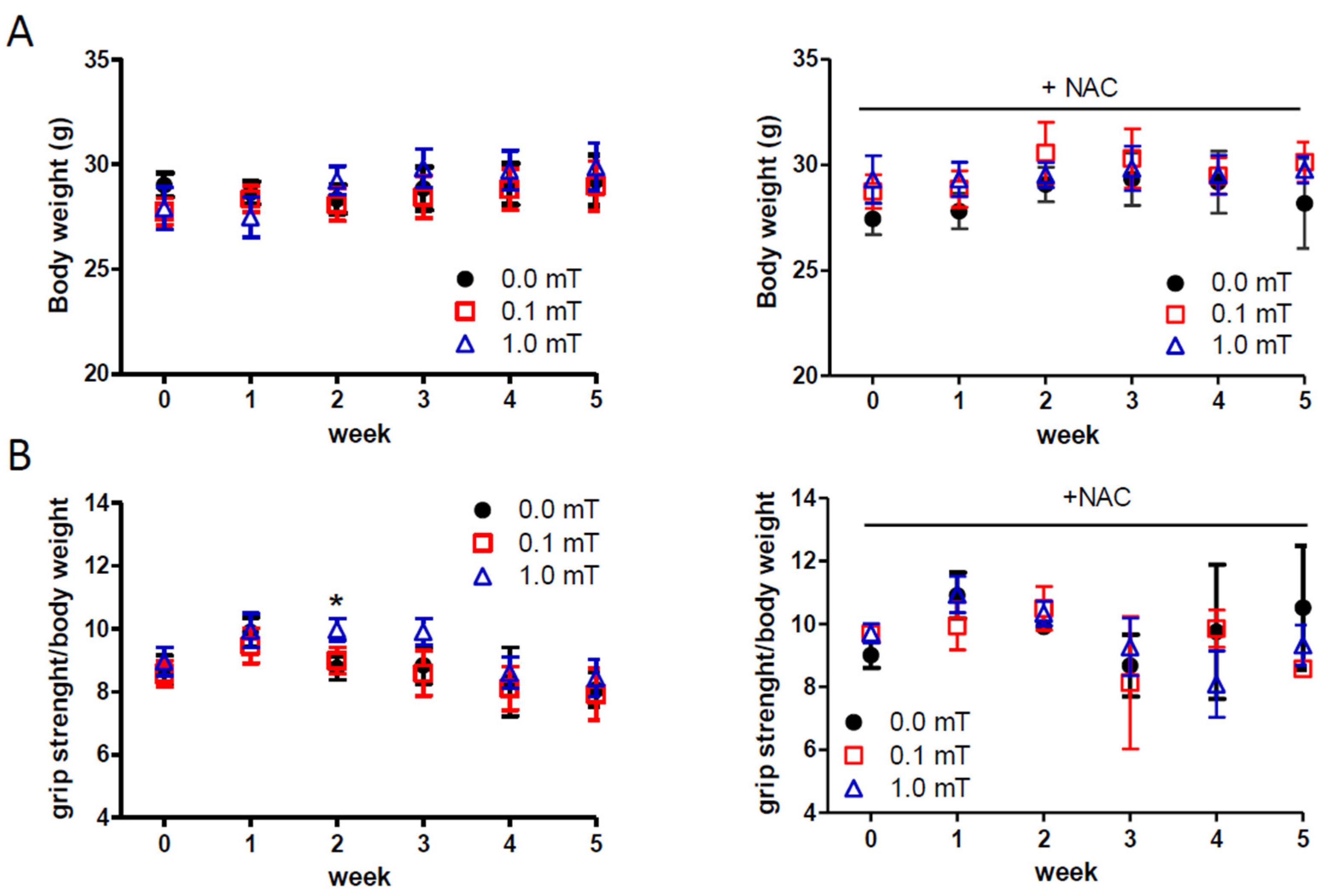
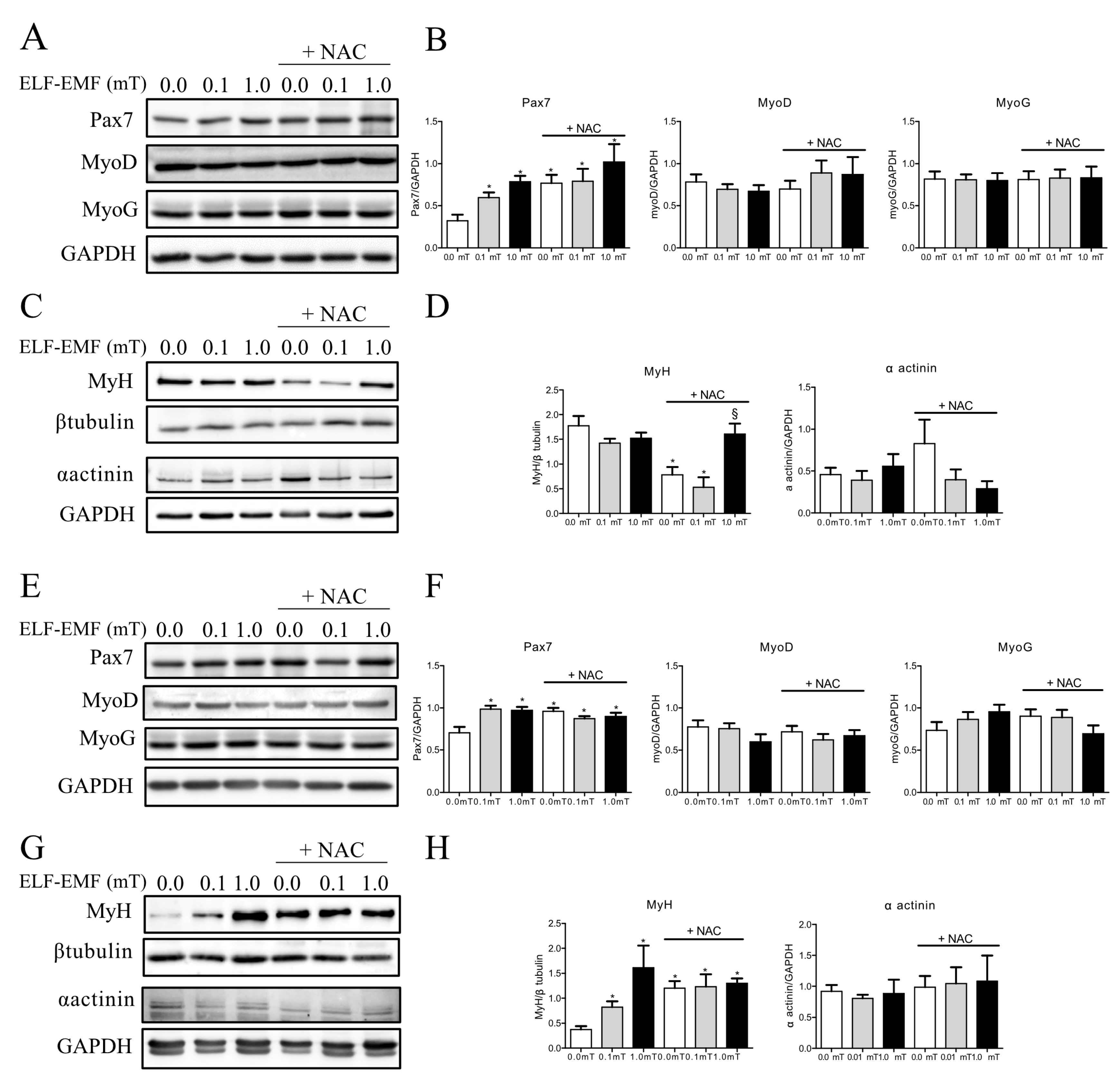
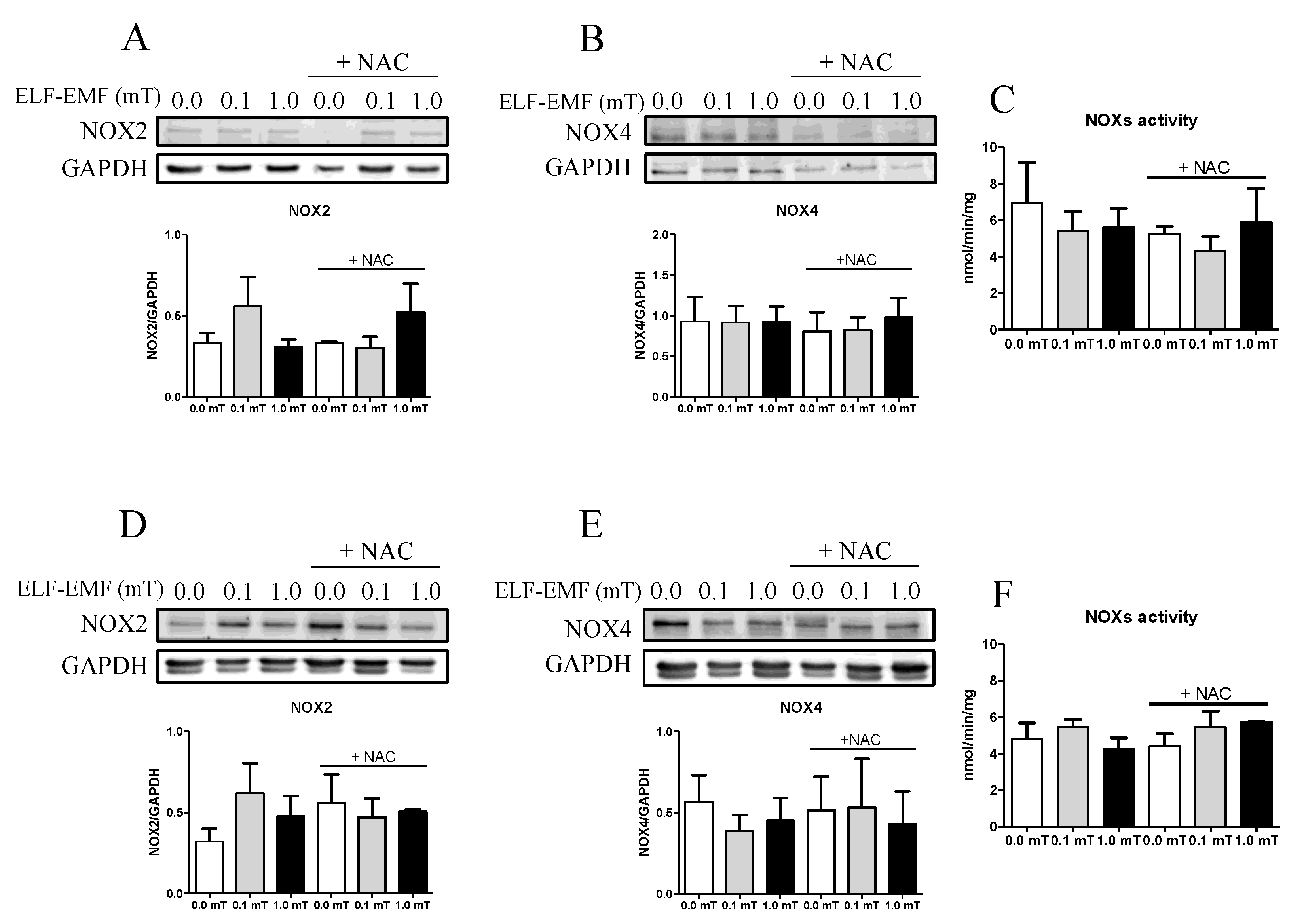
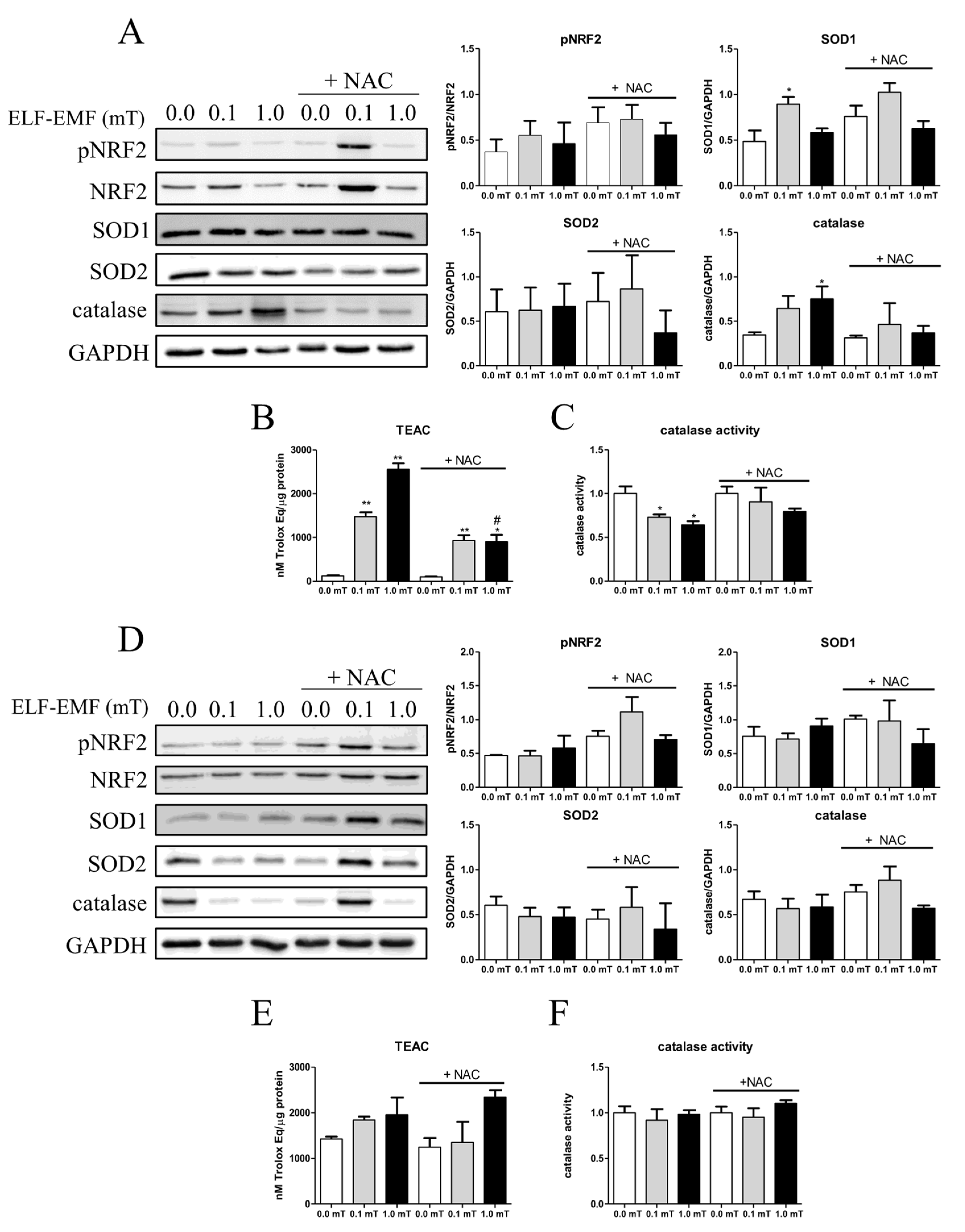
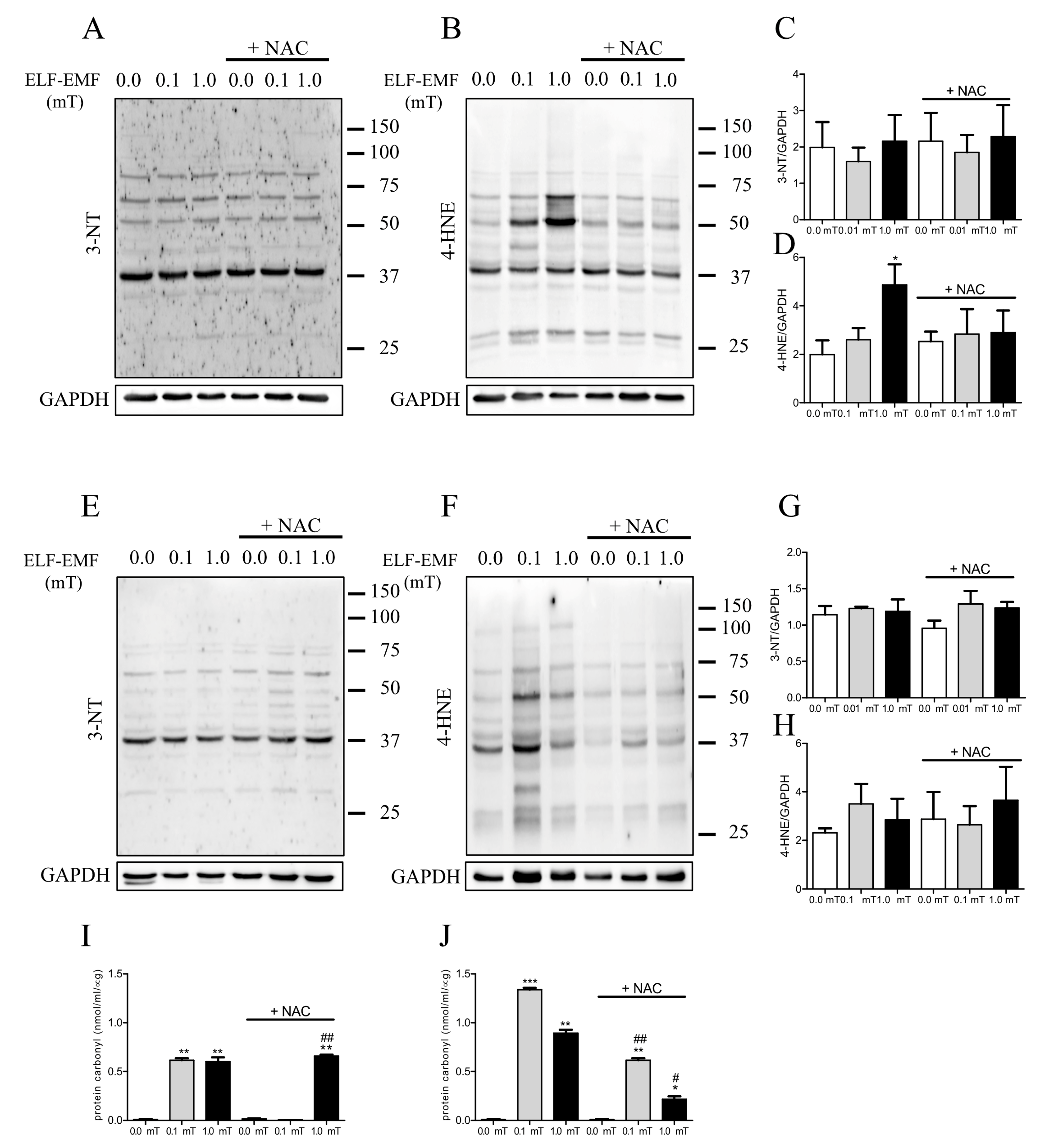

| Group | Exposure Intensity | Exposure Time | Antioxidant Supplementation | Number of Mice |
|---|---|---|---|---|
| Sham n = 24 | 0.0 mT | 1 week | w/o 1% NAC | 6 |
| with 1% NAC | 6 | |||
| 5 weeks | w/o 1% NAC | 6 | ||
| with 1% NAC | 6 | |||
| ELF-EMF n = 48 | 0.1 mT | 1 week | w/o 1% NAC | 6 |
| with 1% NAC | 6 | |||
| 5 weeks | w/o 1% NAC | 6 | ||
| with 1% NAC | 6 | |||
| 1.0 mT | 1 week | w/o 1% NAC | 6 | |
| with 1% NAC | 6 | |||
| 5 weeks | w/o 1% NAC | 6 | ||
| with 1% NAC | 6 |
| Antibody | Working Dilution | Company and Reagent Code |
|---|---|---|
| Mouse monoclonal antibody anti-PAX7 | 1:1000 | Santa Cruz Biotechnology Inc., SantaCruz, CA, USA, cod. sc-81648 |
| Mouse monoclonal antibody anti-MyoD | 1:1000 | Santa Cruz Biotechnology Inc., cod. sc-377460 |
| Mouse monoclonal antibody anti-MyoG | 1:1000 | Santa Cruz Biotechnology Inc., cod. sc-12732 |
| Mouse monoclonal antibody anti-α-actinin | 1:1000 | Merck Life Science S.r.l, cod A7732 |
| Mouse monoclonal antibody anti-MYH | 1:1000 | Santa Cruz Biotechnology Inc., sc-376157 |
| Rabbit polyclonal antibody anti-SOD1 | 1:1000 | Thermo Fisher Scientific, cod. PA527240 |
| Muse monoclonal antibody anti-SOD2 | 1:1000 | Thermo Fisher Scientific, cod. MA5-31514 |
| Rabbit monoclonal antibody anti-catalase | 1:1000 | Cell Signaling Technology, Pero, Italy, cod. 14097 |
| Rabbit monoclonal antibody anti-NRF2 | 1:500 | Merck Life Science S.r.l, cd SAB4501984 |
| Rabbit polyclonal antibody anti-pNRF2 | 1:1000 | Thermo Fisher Scientific, cod PA567520 |
| Mouse monoclonal antibody anti-NOX2 | 1:500 | Santa Cruz Biotechnology Inc., cod. sc-130543 |
| Rabbit monoclonal antibody anti-NOX4 | 1:500 | Thermo Fisher Scientific, cod. MA5-32090 |
| Mouse monoclonal antibody anti-4HNE | 1:1000 | Merck Life Science S.r.l., cod. SAB5202472 |
| Rabbit polyclonal antibody anti-3-nitrotyrosine | 1:1000 | Merck Life Science S.r.l., cod. 4511 |
| Mouse monoclonal antibody anti-β-tubulin (used as loading control) | 1:1000 | Thermo Fisher Scientific, cod MA5-16308 |
| Mouse monoclonal antibody anti-GAPDH (used as loading control) | 1:10,000 | Merck Life Science S.r.l., cod. CB1001 |
Disclaimer/Publisher’s Note: The statements, opinions and data contained in all publications are solely those of the individual author(s) and contributor(s) and not of MDPI and/or the editor(s). MDPI and/or the editor(s) disclaim responsibility for any injury to people or property resulting from any ideas, methods, instructions or products referred to in the content. |
© 2024 by the authors. Licensee MDPI, Basel, Switzerland. This article is an open access article distributed under the terms and conditions of the Creative Commons Attribution (CC BY) license (https://creativecommons.org/licenses/by/4.0/).
Share and Cite
Morabito, C.; Di Sinno, N.; Mariggiò, M.A.; Guarnieri, S. Impact of Extremely Low-Frequency Electromagnetic Fields on Skeletal Muscle of Sedentary Adult Mice: A Pilot Study. Int. J. Mol. Sci. 2024, 25, 9857. https://doi.org/10.3390/ijms25189857
Morabito C, Di Sinno N, Mariggiò MA, Guarnieri S. Impact of Extremely Low-Frequency Electromagnetic Fields on Skeletal Muscle of Sedentary Adult Mice: A Pilot Study. International Journal of Molecular Sciences. 2024; 25(18):9857. https://doi.org/10.3390/ijms25189857
Chicago/Turabian StyleMorabito, Caterina, Noemi Di Sinno, Maria A. Mariggiò, and Simone Guarnieri. 2024. "Impact of Extremely Low-Frequency Electromagnetic Fields on Skeletal Muscle of Sedentary Adult Mice: A Pilot Study" International Journal of Molecular Sciences 25, no. 18: 9857. https://doi.org/10.3390/ijms25189857









